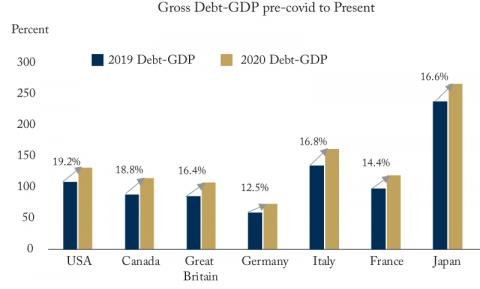From: Miles Wu
To: Canadian Policymakers
Date: November 11, 2020
Re: An International Debt Comparison
Since March, Canada has announced more than over $350 billion in spending measures to confront the pandemic.
Comparing the evolution of Canadian gross debt with the rest of the world, which is also grappling with COVID-19, can help assess our future relative attractiveness for global capital investment. While every G7 country embarked on spending programs to combat the economic fallouts of COVID-19, Canadian governments, provinces included, have spent more than most.
The Figure presents the pre-COVID and current gross debt-GDP situation for G7 countries. Each country faced differing debt situations leading up to the pandemic, and each has responded to the pandemic with varying levels of spending. The US, with gross public debt already above $20 trillion (108 percent of GDP), has added more than $4 trillion with its pandemic response. Italy and Japan had similarly alarming debt levels of 134 and 123 percent of GDP respectively, and both added another roughly 16.5 percent in pandemic spending this year. Meanwhile, Canada, France, the UK, and Germany had seemingly more manageable debts pre-pandemic with debt-GDP ratios under 100 percent. All but Germany have now exceeded that level.
Canada has the second highest COVID-19 spending among G7 countries as a percentage of GDP, behind only the US.
Continuing to outpace other developed nations could raise concerns among investors and credit rating agencies, along with raising fears about future tax increases. This may further dissuade prospective capital investment in key Canadian sectors that boost productivity and raise GDP growth in an environment where we already trail the world.
Miles Wu is a Researcher at the C.D. Howe Institute.
To send a comment or leave feedback, email us at blog@cdhowe.org.
The views expressed here are those of the author. The C.D. Howe Institute does not take corporate positions on policy matters.
Figure 1:
Source: IMF Fiscal Monitor: Policies for the Recovery. October 2020






